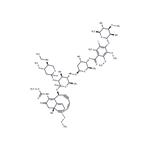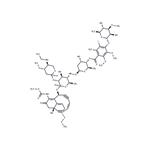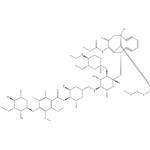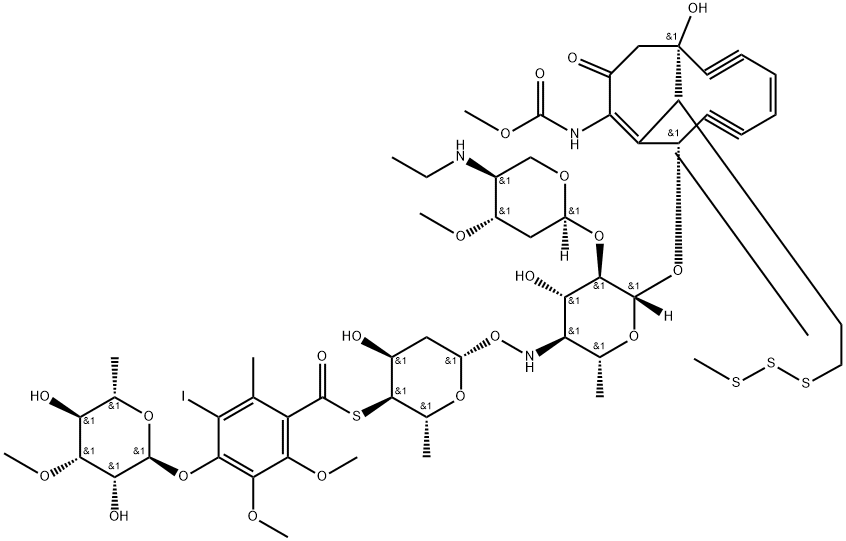
Calicheamicin
- Product NameCalicheamicin
- CAS108212-75-5
- CBNumberCB01353750
- MFC55H74IN3O21S4
- MW1368.34
- MOL File108212-75-5.mol
Chemical Properties
| alpha | D26 -124° (c = 0.98%, EtOH) |
| Density | 1.57±0.1 g/cm3(Predicted) |
| storage temp. | Store at -20°C |
| solubility | DMSO : ≥ 100 mg/mL (73.08 mM);Water : < 0.1 mg/mL (insoluble) |
| form | Solid |
| pka | 7.13±0.60(Predicted) |
| color | White to yellow |
| FDA UNII | 99ZHU54I1K |
Calicheamicin Price
| Product number | Packaging | Price | Product description | Buy |
|---|---|---|---|---|
| ChemScene CS-5320 | 1mg | $350 | Calicheamicin |
Buy |
| ChemScene CS-5320 | 5mg | $800 | Calicheamicin |
Buy |
| American Custom Chemicals Corporation API0015131 | 5MG | $1712.44 | CALICHEAMICIN GAMMA(1)I 95.00% |
Buy |
| American Custom Chemicals Corporation API0015131 | 10MG | $2887.5 | CALICHEAMICIN GAMMA(1)I 95.00% |
Buy |
| American Custom Chemicals Corporation API0015131 | 100MG | $14700 | CALICHEAMICIN GAMMA(1)I 95.00% |
Buy |
Calicheamicin Chemical Properties,Usage,Production
description
Calicheamicins are a series of enediyne antitumor antibiotics originally isolated from the bacterium Micromonospora echinospora. They exert high cytotoxicity and have been applied in tumor therapies for over a decade-- a CD33 antigen-targeted immuno-conjugate: N-acetyl dimethyl hydrazide calicheamicin, was developed as a targeted therapy for non-solid tumor cancer acute myeloid leukemia (AML). Calicheamicin has several derivatives with different chemical modifications, among which γ1 is the most well-characterized. Calicheamicin γ1 contains an aglycon consisting of a bicycle tridec-9-ene-2,6-diyne system with a labile methyl trisulfide group and an aryltetrasaccharide chain. Calicheamicins also contain enediyne moieties that are structurally similar to other enediynes, such as esperamicins, neocarzinostatin, and kedarcidin, etc. After reduction by cellular thiols, the calicheamicin enediyne moieties rearrange to produce a 1, 4-benzenoid diradical.Mode of Action
Calicheamicins are highly toxic agents against DNA and they induce double-stranded DNA (dsDNA) breakages at sub-picomolar concentrations. For their mode of action, Calicheamicins bind to dsDNA minor groove, within which they undergo a cyclization reaction similar to Bergman cyclization and release a diradical species, namely 1,4-didehydrobenzene. 1,4-didehydrobenzene subsequently extracts hydrogen atoms from DNA deoxyribose (sugar) backbone, resulting in strand scission. The strong potency of the calicheamicins fits the concept of ADC payloads and they have been proven to be outstanding drug candidates for targeted cancer therapies. A hydrazide derived from Calicheamicin γ1 has been conjugated to the proteoglycan portion of the CT-M-01 (anti-polyepithelial mucin) antibody and the resulted ADC has shown promising effects to human breast carcinoma cells.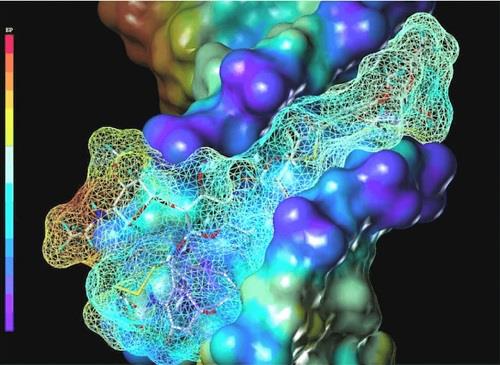
Calicheamicins mode of action. Once inside the cells, Calicheamicin diffuses into the cell nucleus, where it binds to the DNA minor groove (modeled in the image) and induces double stranded DNA breakages. DNA breakages result in the elimination of the malignant cells by apoptosis.
Uses
Calicheamicin, also known as Calicheamicin gamma(1,I) or Calichemicin gamma1, is an potent enediyne antitumor antibiotics derived from the bacterium Micromonospora echinospora. Calicheamicin targets DNA and cause strand scission. Calicheamicin binds with DNA in the minor groove, wherein it then undergos a reaction analogous to the Bergman cyclization to generate a diradical species. This diradical, 1,4-didehydrobenzene, then abstracts hydrogen atoms from the deoxyribose (sugar) backbone of DNA, which ultimately leads to strand scission. The specificity of binding of calicheamicin to the minor groove of DNA is due to the aryltetrasaccharide group of the molecule.Resistance
Calicheamicin displays unbiased toxicity to bacteria, fungi, viruses, and eukaryotic cells and organisms, which raises questions as to how the calicheamicin-producing Micromonospora manages not to poison itself. An answer to this question was presented in 2003 when Thorson and coworkers presented the first known example of a "self-sacrifice" resistance mechanism encoded by the gene calC from the calicheamicin biosynthetic gene cluster. In this study, the scientists revealed calicheamicin to cleave the protein CalC site-specifically, destroying both the calicheamicin and the CalC protein, thereby preventing DNA damage. The same group went on to solve the structure of CalC and, more recently, in collaboration with scientists from the Center for Pharmaceutical Research and Innovation (CPRI), discover structural or functional homologs encoded by genes in the calicheamicin gene cluster previously listed as encoding unknown function. In this latter study, the authors suggest that CalC homologs may serve in a biosynthetic capacity as the long-sought-after polyketide cyclases required to fold or cyclize early intermediates en route to calicheamicin.Structure
Calicheamicin represents one of the most structurally complex natural products developed into an anticancer agent. The compound was isolated from the fermentation broth of a bacterium, Micromonospora echinospora ssp. calichensis. It contains four carbohydrate residues, a hexasubstituted benzene ring, an unusual N–O glycosidic linkage, a trisulfide moiety, and a bicycle[7.3.1]tridec-9-ene-2, 6-diyne system. The aglycon portion of calicheamicin and other 10-membered ring enediyne antitumor antibiotics contain dienonecarbamate and enediyne chromophores in a unique bicyclic ring structure in which these two subunits are essentially orthogonal to each other. After binding to the minor groove of DNA with some sequence specificity, calicheamicin is reduced by cellular thiols[1-2].Description
Calicheamicin gamma1 is an enediyne antitumor antibiotic that binds with DNA in the minor groove and is derived from the bacterium Micromonospora echinospora.History
calicheamicin gamma has been proposed that Alexander the Great was poisoned by drinking the water of the river Mavroneri (identified with the mythological River Styx) which is postulated to have been contaminated by this compound. However, toxicologists believe an extensive knowledge of biological chemistry would have been requisite for any application of this poison in antiquity.Uses
Calicheamicins are a class of enediyne antitumor antibiotics derived from the bacterium Micromonospora echinospora, The main component is calicheamicin γ1. It has strong anti-Gram-positive bacteria activity and anti-tumor effect.Biological Activity
Calicheamicin γ1 is an enediyne antitumor antibiotic that acts by binding to DNA and causes strand scission; ADC payload used in development of antibody drug conjugates.Mechanism of action
Calicheamicins target DNA and cause strand scission. Calicheamicins bind with DNA in the minor groove, wherein they then undergo a reaction analogous to the Bergman cyclization to generate a diradical species. This diradical, 1,4-didehydrobenzene, then abstracts hydrogen atoms from the deoxyribose (sugar) backbone of DNA, which ultimately leads to strand scission.The specificity of binding of calicheamicin to the minor groove of DNA was demonstrated by Crothers et al. (1999) to be due to the aryltetrasaccharide group of the molecule.in vitro
PF-06647263 (anti-EFNA4-ADC) is generated via conjugation of hE22 lysine residues to the AcButDMH-N-Ac-calicheamicin-γ1 linker-payload with an average drug-to-antibody ratio (DAR) of 4.6. PF-06647263 elicits antigen- and concentration-dependent cytotoxicity, as exposure to PF-06647263 for 96 hours results in cell death (EC 50 = appr 1 ng/mL). CMC-544, consisting of a humanized CD22 Ab linked to calicheamicin, is effective in pediatric primary B-cell precursor acute lymphoblastic leukemia (BCP-ALL) cells in vitro. CMC-544 induces cell death in various ALL cell lines in a dose- and time-dependent way, with IC 50 values ranging from 0.15 to 4.9?ng/mL. CMC-544 (10?ng/mL) is effective and specific in primary BCP-ALL cells. In CMC-544-treated cells, the level of CD22 has decreased relative to that on G5/44-treated cells and continued to decrease.in vivo
An ADC comprising a humanized anti-EFNA4 monoclonal antibody conjugated to the DNA-damaging agent calicheamicin achieves sustained tumor regressions in both TNBC and ovarian cancer PDX in vivo. PF-06647263 (0.27, 0.36 mg/kg) results in significant tumor regressions in TNBC xenografts.target
CalicheamicinsReferences
[1] Huryn, D. and P. Wipf. “CHAPTER 5 – Natural product chemistry and anticancer drug discovery.”Cancer Drug Design and Discovery (2008) 107-130.[2] Berova, N. G. Ellestad and N. Harada. “Characterization by Circular Dichroism Spectroscopy.”Comprehensive Natural Products II (2010): 91-146.
Preparation Products And Raw materials
Preparation Products
Calicheamicin Supplier
Global(128)Suppliers
| Supplier | Tel | Country | ProdList | Advantage | |
|---|---|---|---|---|---|
| +86-371-86557731 +86-13613820652 |
info@fdachem.com | China | 20254 | 58 | |
| +undefined-21-51877795 | ivan@atkchemical.com | China | 33024 | 60 | |
| +1-631-485-4226 | inquiry@bocsci.com | United States | 19552 | 58 | |
| 13656108824 | coupling278191416@hotmail.com | CHINA | 184 | 58 | |
| +86-0371-86658258 +8613203830695 |
factory@coreychem.com | China | 29808 | 58 | |
| +86-021-61551413 +8618813727289 |
contact@trustwe.com | China | 5738 | 58 | |
| +8617531153977 | allison@yan-xi.com | China | 5855 | 58 | |
| +1-781-999-5354 +1-00000000000 |
marketing@targetmol.com | United States | 32159 | 58 | |
| +8613367258412 | ada@ipurechemical.com | China | 10319 | 58 | |
| 86-571-88216897,88216896 13588875226 |
sales@hzclap.com | CHINA | 6312 | 58 |
Related articles
Calicheamicin gamma1 Unveiled: Pathway from Microbial Marvel to Therapeutic Powerhouse
Calicheamicin gamma1, a marvel of natural product chemistry, has emerged as a beacon of hope in the ongoing battle against cancer.
Jan 14,2025
Calicheamicin and Calicheamicin gamma 1I
Calicheamicin gamma 1I is a discovered diyne-ene--containing antitumor antibiotic with considerable potency against murine tumors.
Apr 15,2024
Calicheamicin: Bioactivity, Mechanism of action, Application
Calicheamicin is a potent cytotoxic agent that can cause DNA double strand breaks.
Dec 13,2022
Calicheamicin Spectrum
108212-75-5, Calicheamicin Related Search
PROMPT×
PROMPT
The What'sApp is temporarily not supported in mainland China
The What'sApp is temporarily not supported in mainland China
Cancel
Determine

